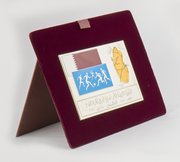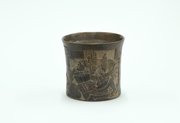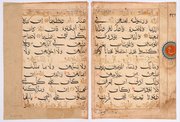
Gilded Blue Glass Flask
Museum of Islamic Art
- Title:
- Gilded Blue Glass Flask
- Production place:
- Raqqa
- Date:
- 1100 - 1199
- Period:
- 12th century CE
- Title:
- Gilded Blue Glass Flask
- Production place:
- Raqqa
- Date:
- 1100 - 1199
- Period:
- 12th century CE
- Material:
- Glass, Gold
- Technique:
- Glassblowing, Gilding
- Dimensions:
- 24.0 cm
- Diameter:
- 6.9 cm
This gilded blue flask is an extremely rare example of 6th century AH/12th century CE Syrian glass. Free blown, of a cylindrical form narrowing to a flattened, kicked-in base and a shortened neck, this flask rather curiously cannot stand upright on its own, thus requiring the assistance of a steady hand or holder. Its painted gold decoration – made of particles of gold suspended in liquid, painted and then reheated onto the glass surface – remain in pristine condition, suggesting minimal use and exceptional storage conditions. Based on stylistic comparisons with an inscribed fragmentary glass flask currently in the British Museum – attributed to ‘Imad al-Din Zang, the founder of the Zangid dynasty and Turkish governor of Mosul (520-541 AH/1127-1146 CE) – this flask presents a sophisticated gilded decoration of birds flanking a pomegranate tree (a sign of both the earthly and heavenly gardens) that supports its courtly commission. Most probably made in the known glass-working center of Raqqa, situated on the Euphrates in the northeast of the country, Raqqa served as an important commercial center known for producing fine glass specimens that were traded readily throughout the eastern Mediterranean.



